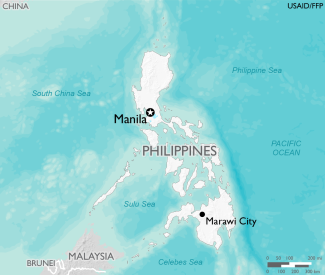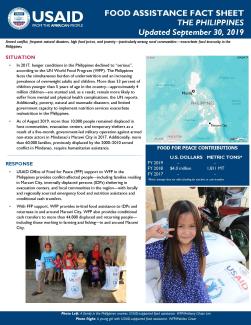September 30, 2019
Armed conflict, frequent natural disasters, high food prices, and poverty—particularly among rural communities—exacerbate food insecurity in the Philippines.
Situation
- In 2017, hunger conditions in the Philippines declined to “serious”, according to the UN World Food Program (WFP). The Philippines faces the simultaneous burden of undernutrition and an increasing prevalence of overweight adults and children. More than 33 percent of children younger than 5 years of age in the country—approximately 4 million children—are stunted and, as a result, remain more likely to suffer from mental and physical health complications, the UN reports. Additionally, poverty, natural and manmade disasters, and limited government capacity to implement nutrition services exacerbate malnutrition in the Philippines.
- As of August 2019, more than 10,000 people remained displaced in host communities, evacuation centers, and temporary shelters as a result of a five-month, government-led military operation against armed non-state actors in Mindanao’s Marawi City in 2017. Additionally, more than 60,000 families, previously displaced by the 2000–2010 armed conflict in Mindanao, require humanitarian assistance.
Response
- USAID Office of Food for Peace (FFP) support to WFP in the Philippines provides conflict-affected people—including families residing in Marawi City, internally displaced persons (IDPs) sheltering in evacuation centers, and local communities in the region—with locally and regionally sourced emergency food and nutrition assistance and conditional cash transfers.
- With FFP support, WFP provides in-kind food assistance to IDPs and returnees in and around Marawi City. WFP also provides conditional cash transfers to more than 44,800 displaced and returning people—including those working in farming and fishing—in and around Marawi City.
Food for Peace Contributions
Total Contributions:
| U.S. Dollars | Metric Tons | |
|---|---|---|
| Fiscal Year 2019 | ---- | ---- |
| Fiscal Year 2018 | $4.0 million | 1,811 MT |
| Fiscal Year 2017 | ---- | ---- |
* Metric tonnage does not reflect funding for vouchers or cash transfers.
Image

(300.67 KB)

